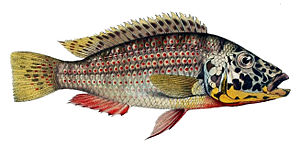Red point mouthbrooders
| Red point mouthbrooders | ||||||||||||
|---|---|---|---|---|---|---|---|---|---|---|---|---|

Red-point mouthbrooder ( Ctenochromis horei ) |
||||||||||||
| Systematics | ||||||||||||
|
||||||||||||
| Scientific name | ||||||||||||
| Ctenochromis horei | ||||||||||||
| ( Günther , 1894) |
The red point mouthbrooder ( Ctenochromis horei , Syn . : Haplochromis horei ) is a species of cichlid that occurs in the East African Lake Tanganyika , some of its tributaries ( Ruzizi , Nua) and in the Lukuga , the only outflow of Lake Tanganyika. The species was named after the fish collector Coode-Hoore.
features
The red-point mouth-brooder reaches a length of 16 to 20 cm and has a whitish basic color and numerous regularly arranged small, orange spots on the body. In case of malaise, danger or aggressive behavior, the species shows 8 to 10 dark cross bars. The head drawing is characterized by an irregular dark pattern. In the males, the head and chest are golden-yellow to reddish and black-brown.
Way of life
The red-point mouthbrooder lives close to the coast, especially in the Vallisneria meadows of the sandy zones. The species is completely absent in deep water or over rocky ground. It feeds largely piscivor and with its powerful mouth can overwhelm fish that are almost half the size of the red-point mouth-brooders. In addition to carp fish, its prey fish include the sand cichlids of the genera Callochromis and Xenotilapia . Like all haplochromine cichlids, the red-point mouthbrooder protects eggs and juvenile fish in the female's mouth.
Individual evidence
- ↑ Hans J. Mayland: Cichlids. Landbuch Verlag, 1995, ISBN 3-7842-0507-0 . Page 163 a. 164.
- ↑ Pierre Brichard: The Great Book of Tanganyika Cichlids. With all the other fish on Lake Tanganyika. Bede Verlag, 1995, ISBN 978-3927997943 . Page 304 a. 305
Web links
- Ctenochromis horei on Fishbase.org (English)